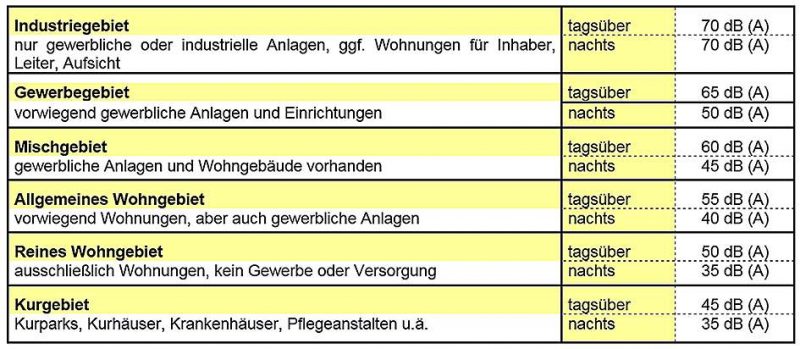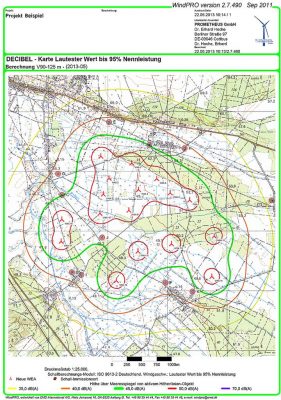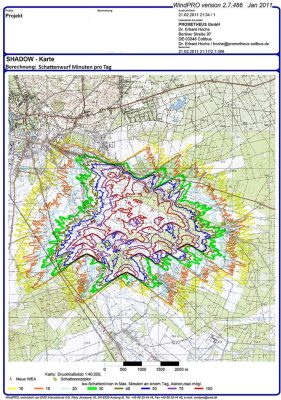Especially with regards to the building of wind turbines, the sound immissions arising in the soundings of the selected locations must be evaluated with regards to whether the standard values set forth by the Sixth General Administrative Regulation to the Federal Immission Control Act (technical instructions for safety against noise – “TA Lärm”) can be observed:

This evaluation is done in a sound immission prognosis. Among other things, this takes into consideration the guidelines of the technical instructions for safety against noise, the DIN/ISO 9613-2, DIN EN 50376 and if necessary, special state-specific regulations and enactments.
The calculation of sound propagation is done using appropriate software; the submitted report entails the following key points:

- Explanation of the procedure of sound propagation calculation and description of relevant influencing variables
- Site inspection with assessment of relevant immission locations and description of the surroundings
- Description of the topography in the site surrounding
- Determination of the existing load due to other wind turbines or other sound emitters
- Description of the database underlying the immission calculation
- Determination of the prior, additional and total load in the individual immission locations
- Evaluation of permissibility using standard specified in the technical instructions for safety against noise
- determination of the prognosis quality (error analysis)
- Representation of the isophones (lines of equal immission values) on the topographical map
-
Proposal for measures if exceeding of guide values is expected
During operation of wind turbines, periodical shadow flickers occur in the surroundings of a wind turbine due to the revolving rotor. Studies have shown that prolonged exposure to this strong light change can evoke stress situations.
This should therefore be considered in the planning phase and a prognosis calculation for the expected impact determined. Recommendations of the Federal Committee for Immission Control consider the following values acceptable:

The shadow flicker prognosis allows conclusions to be drawn about the times when periodical shadow flicker can be determined for selected living or working locations in the surroundings (shadow receptors). Generally, the calculation may be based on two different approaches:
Determination of the astronomically maximally possible shadowing – the worst case is calculated.
Determination of the meteorologically likely shadowing – the meteorologically most likely shadow duration based on statistical values with regards to sunlight and wind is calculated.
Calculation of the times with periodical shadow flicker takes place using special software; the submitted report contains statements regarding the following key points:


- Determination of the prior, additional and total load at the individual shadow receptors
- Evaluation of the permissibility using the standard of the Federal Committee for Immission Control
- Detailed documentation of the determined times (tabular and graphical)
- Representation of the lines of equal shadow flicker duration on a topographical map
- Proposal for measures if exceeding of guide values is expected
- Explanation of the procedure of shadow flicker calculation and description of relevant influencing variables
- Site inspection with gathering of relevant immission locations and description of the surroundings
- Description of the topography in the site surroundings
- Determination of the existing load due to other wind turbines
-
Calculation of the number of days with shadow flicker as well as the shadow flicker duration per day and per year
Anfahrt • Impressum • Datenschutz • Sitemap







